Business and Business Environment Report: Analysis of M&S Company
VerifiedAdded on 2020/07/22
|14
|4089
|98
Report
AI Summary
This report provides a comprehensive analysis of the business environment, specifically focusing on Marks and Spencer (M&S). It begins by exploring the purposes and characteristics of private, public, and charity companies, highlighting M&S as a case study for the private sector, NHS for the public sector, and Oxfam for the charity sector. The report then delves into the size and scope of these different types of companies, examining their strategies for growth and market expansion. A significant portion is dedicated to dissecting the departmental functions within M&S, including HR, marketing, finance, administration, and research and development, emphasizing their interdependencies and impact on overall performance. Furthermore, the report includes a critical analysis of the complexities of different business structures and their interrelationships, alongside a PESTLE analysis to assess the macro-environmental factors influencing M&S, such as political, economic, social, and technological aspects, and the impact of these factors on the company's operations and strategies. The report concludes with an evaluation of the positive and negative impacts of the macro-environment on M&S and a SWOT analysis to understand the internal strengths and weaknesses and external opportunities and threats.
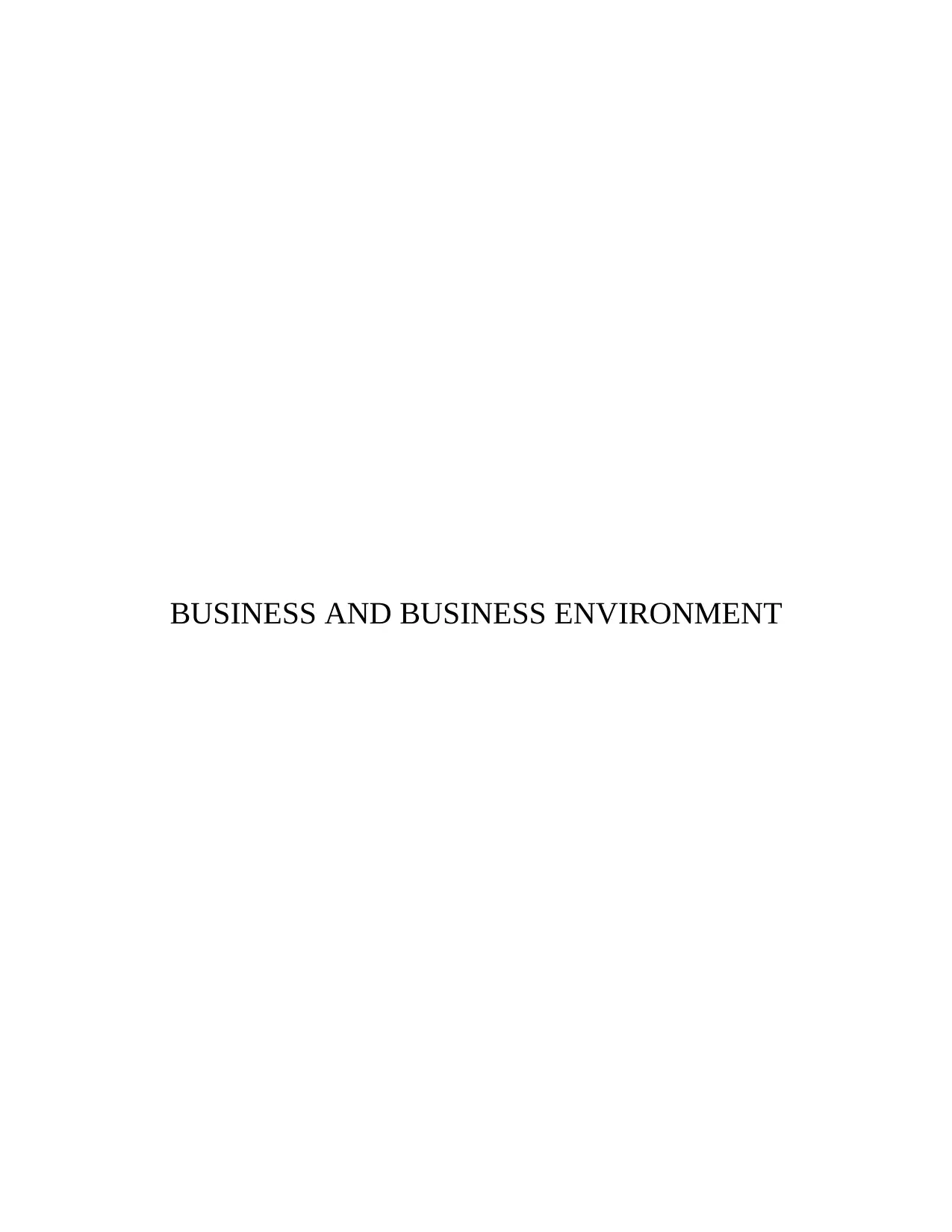
BUSINESS AND BUSINESS ENVIRONMENT
Paraphrase This Document
Need a fresh take? Get an instant paraphrase of this document with our AI Paraphraser

TABLE OF CONTENTS
INTRODUCTION...........................................................................................................................1
TASK 1 ...........................................................................................................................................1
P1 Purpose of private, public and charity companies.............................................................1
P2 Size and scope of private, public and charity companies..................................................2
P3 Departmental functions within M&S................................................................................3
D1 Critical analysis of complexities of different types of business structure and the
Interrelationship of different company functions...................................................................5
TASK 2............................................................................................................................................5
P4 Positive and negative impact of macro environment in M&S..........................................5
P5 SWOT analysis..................................................................................................................6
P6 Interrelationship with macro environment based on SWOT analysis...............................8
CONCLUSION ...............................................................................................................................9
REFERENCES..............................................................................................................................10
INTRODUCTION...........................................................................................................................1
TASK 1 ...........................................................................................................................................1
P1 Purpose of private, public and charity companies.............................................................1
P2 Size and scope of private, public and charity companies..................................................2
P3 Departmental functions within M&S................................................................................3
D1 Critical analysis of complexities of different types of business structure and the
Interrelationship of different company functions...................................................................5
TASK 2............................................................................................................................................5
P4 Positive and negative impact of macro environment in M&S..........................................5
P5 SWOT analysis..................................................................................................................6
P6 Interrelationship with macro environment based on SWOT analysis...............................8
CONCLUSION ...............................................................................................................................9
REFERENCES..............................................................................................................................10
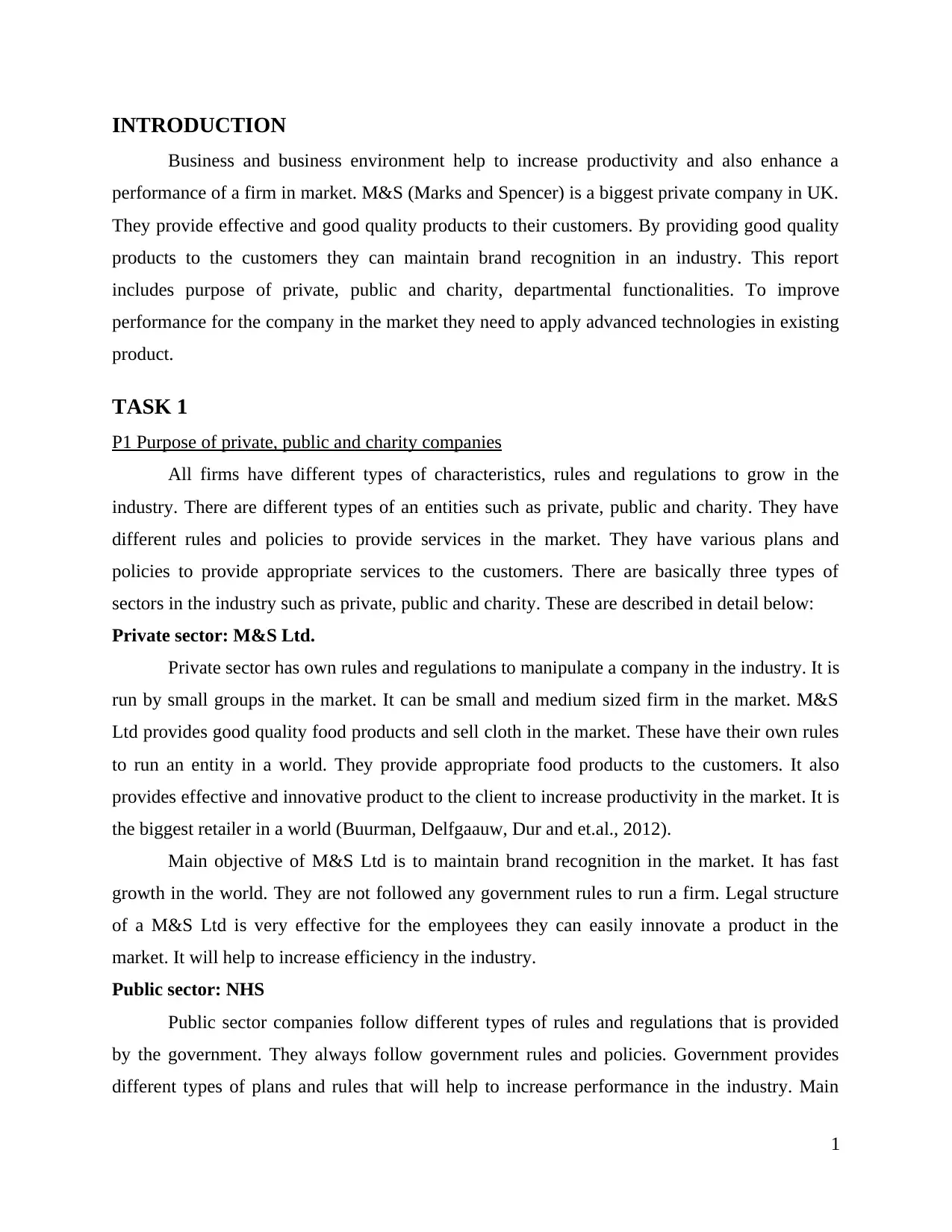
INTRODUCTION
Business and business environment help to increase productivity and also enhance a
performance of a firm in market. M&S (Marks and Spencer) is a biggest private company in UK.
They provide effective and good quality products to their customers. By providing good quality
products to the customers they can maintain brand recognition in an industry. This report
includes purpose of private, public and charity, departmental functionalities. To improve
performance for the company in the market they need to apply advanced technologies in existing
product.
TASK 1
P1 Purpose of private, public and charity companies
All firms have different types of characteristics, rules and regulations to grow in the
industry. There are different types of an entities such as private, public and charity. They have
different rules and policies to provide services in the market. They have various plans and
policies to provide appropriate services to the customers. There are basically three types of
sectors in the industry such as private, public and charity. These are described in detail below:
Private sector: M&S Ltd.
Private sector has own rules and regulations to manipulate a company in the industry. It is
run by small groups in the market. It can be small and medium sized firm in the market. M&S
Ltd provides good quality food products and sell cloth in the market. These have their own rules
to run an entity in a world. They provide appropriate food products to the customers. It also
provides effective and innovative product to the client to increase productivity in the market. It is
the biggest retailer in a world (Buurman, Delfgaauw, Dur and et.al., 2012).
Main objective of M&S Ltd is to maintain brand recognition in the market. It has fast
growth in the world. They are not followed any government rules to run a firm. Legal structure
of a M&S Ltd is very effective for the employees they can easily innovate a product in the
market. It will help to increase efficiency in the industry.
Public sector: NHS
Public sector companies follow different types of rules and regulations that is provided
by the government. They always follow government rules and policies. Government provides
different types of plans and rules that will help to increase performance in the industry. Main
1
Business and business environment help to increase productivity and also enhance a
performance of a firm in market. M&S (Marks and Spencer) is a biggest private company in UK.
They provide effective and good quality products to their customers. By providing good quality
products to the customers they can maintain brand recognition in an industry. This report
includes purpose of private, public and charity, departmental functionalities. To improve
performance for the company in the market they need to apply advanced technologies in existing
product.
TASK 1
P1 Purpose of private, public and charity companies
All firms have different types of characteristics, rules and regulations to grow in the
industry. There are different types of an entities such as private, public and charity. They have
different rules and policies to provide services in the market. They have various plans and
policies to provide appropriate services to the customers. There are basically three types of
sectors in the industry such as private, public and charity. These are described in detail below:
Private sector: M&S Ltd.
Private sector has own rules and regulations to manipulate a company in the industry. It is
run by small groups in the market. It can be small and medium sized firm in the market. M&S
Ltd provides good quality food products and sell cloth in the market. These have their own rules
to run an entity in a world. They provide appropriate food products to the customers. It also
provides effective and innovative product to the client to increase productivity in the market. It is
the biggest retailer in a world (Buurman, Delfgaauw, Dur and et.al., 2012).
Main objective of M&S Ltd is to maintain brand recognition in the market. It has fast
growth in the world. They are not followed any government rules to run a firm. Legal structure
of a M&S Ltd is very effective for the employees they can easily innovate a product in the
market. It will help to increase efficiency in the industry.
Public sector: NHS
Public sector companies follow different types of rules and regulations that is provided
by the government. They always follow government rules and policies. Government provides
different types of plans and rules that will help to increase performance in the industry. Main
1
⊘ This is a preview!⊘
Do you want full access?
Subscribe today to unlock all pages.

Trusted by 1+ million students worldwide
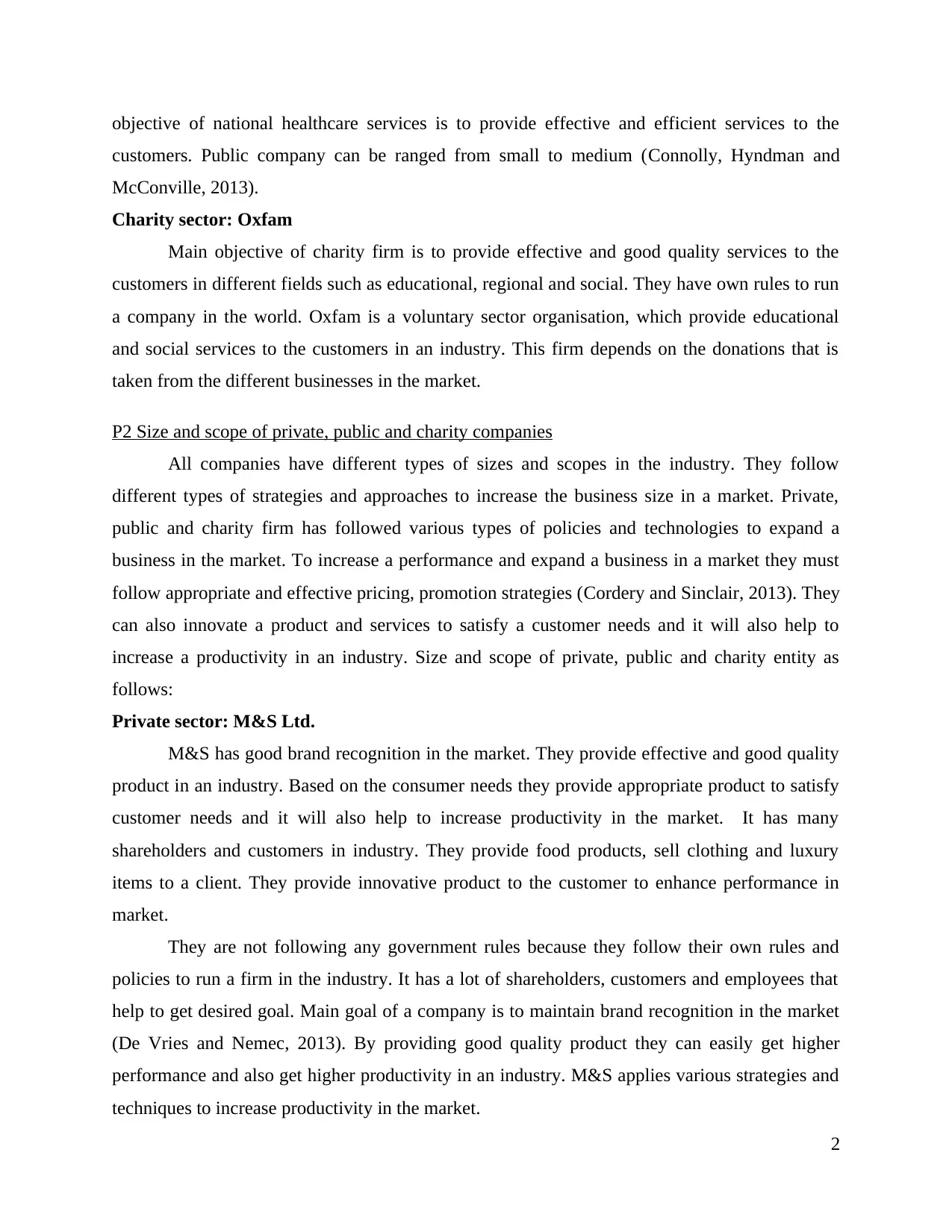
objective of national healthcare services is to provide effective and efficient services to the
customers. Public company can be ranged from small to medium (Connolly, Hyndman and
McConville, 2013).
Charity sector: Oxfam
Main objective of charity firm is to provide effective and good quality services to the
customers in different fields such as educational, regional and social. They have own rules to run
a company in the world. Oxfam is a voluntary sector organisation, which provide educational
and social services to the customers in an industry. This firm depends on the donations that is
taken from the different businesses in the market.
P2 Size and scope of private, public and charity companies
All companies have different types of sizes and scopes in the industry. They follow
different types of strategies and approaches to increase the business size in a market. Private,
public and charity firm has followed various types of policies and technologies to expand a
business in the market. To increase a performance and expand a business in a market they must
follow appropriate and effective pricing, promotion strategies (Cordery and Sinclair, 2013). They
can also innovate a product and services to satisfy a customer needs and it will also help to
increase a productivity in an industry. Size and scope of private, public and charity entity as
follows:
Private sector: M&S Ltd.
M&S has good brand recognition in the market. They provide effective and good quality
product in an industry. Based on the consumer needs they provide appropriate product to satisfy
customer needs and it will also help to increase productivity in the market. It has many
shareholders and customers in industry. They provide food products, sell clothing and luxury
items to a client. They provide innovative product to the customer to enhance performance in
market.
They are not following any government rules because they follow their own rules and
policies to run a firm in the industry. It has a lot of shareholders, customers and employees that
help to get desired goal. Main goal of a company is to maintain brand recognition in the market
(De Vries and Nemec, 2013). By providing good quality product they can easily get higher
performance and also get higher productivity in an industry. M&S applies various strategies and
techniques to increase productivity in the market.
2
customers. Public company can be ranged from small to medium (Connolly, Hyndman and
McConville, 2013).
Charity sector: Oxfam
Main objective of charity firm is to provide effective and good quality services to the
customers in different fields such as educational, regional and social. They have own rules to run
a company in the world. Oxfam is a voluntary sector organisation, which provide educational
and social services to the customers in an industry. This firm depends on the donations that is
taken from the different businesses in the market.
P2 Size and scope of private, public and charity companies
All companies have different types of sizes and scopes in the industry. They follow
different types of strategies and approaches to increase the business size in a market. Private,
public and charity firm has followed various types of policies and technologies to expand a
business in the market. To increase a performance and expand a business in a market they must
follow appropriate and effective pricing, promotion strategies (Cordery and Sinclair, 2013). They
can also innovate a product and services to satisfy a customer needs and it will also help to
increase a productivity in an industry. Size and scope of private, public and charity entity as
follows:
Private sector: M&S Ltd.
M&S has good brand recognition in the market. They provide effective and good quality
product in an industry. Based on the consumer needs they provide appropriate product to satisfy
customer needs and it will also help to increase productivity in the market. It has many
shareholders and customers in industry. They provide food products, sell clothing and luxury
items to a client. They provide innovative product to the customer to enhance performance in
market.
They are not following any government rules because they follow their own rules and
policies to run a firm in the industry. It has a lot of shareholders, customers and employees that
help to get desired goal. Main goal of a company is to maintain brand recognition in the market
(De Vries and Nemec, 2013). By providing good quality product they can easily get higher
performance and also get higher productivity in an industry. M&S applies various strategies and
techniques to increase productivity in the market.
2
Paraphrase This Document
Need a fresh take? Get an instant paraphrase of this document with our AI Paraphraser
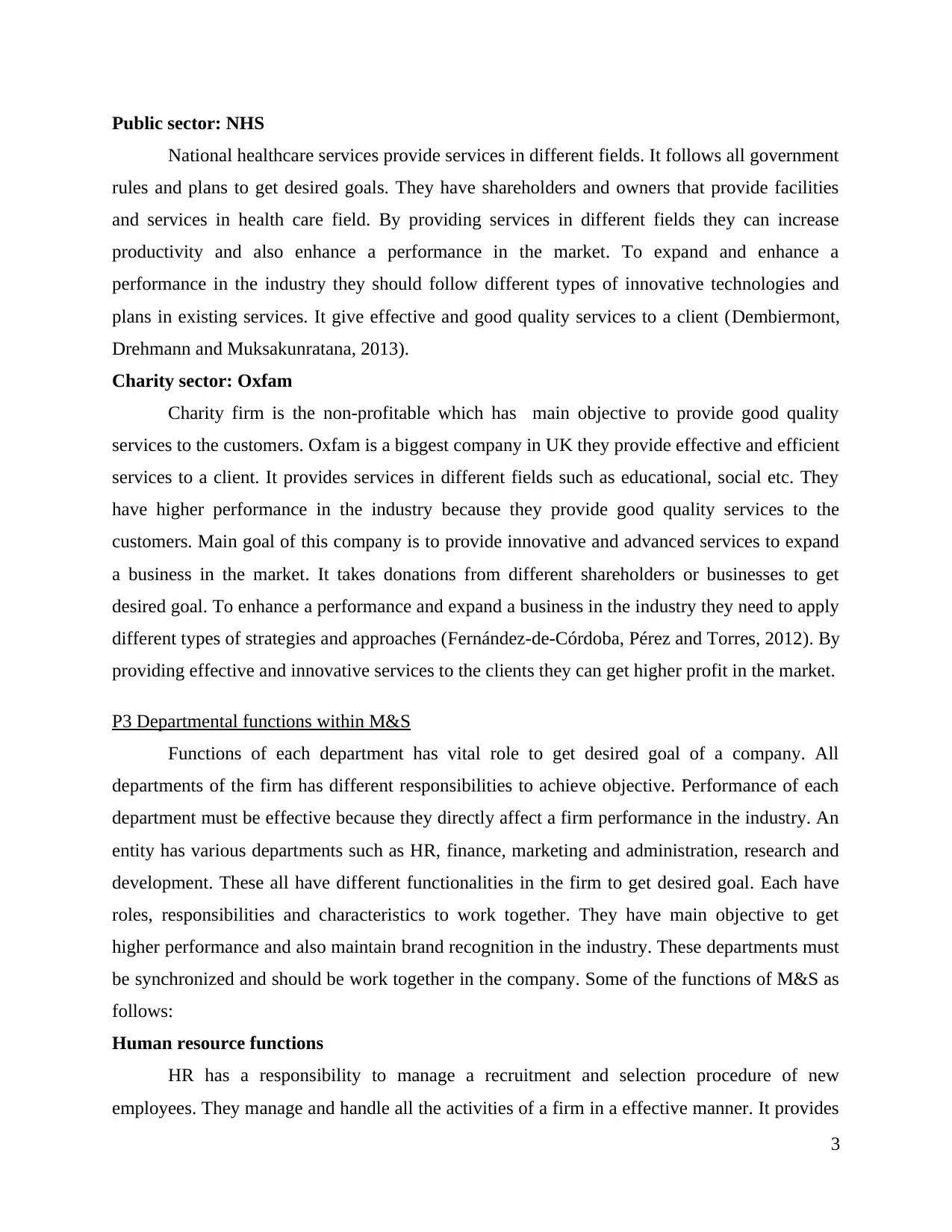
Public sector: NHS
National healthcare services provide services in different fields. It follows all government
rules and plans to get desired goals. They have shareholders and owners that provide facilities
and services in health care field. By providing services in different fields they can increase
productivity and also enhance a performance in the market. To expand and enhance a
performance in the industry they should follow different types of innovative technologies and
plans in existing services. It give effective and good quality services to a client (Dembiermont,
Drehmann and Muksakunratana, 2013).
Charity sector: Oxfam
Charity firm is the non-profitable which has main objective to provide good quality
services to the customers. Oxfam is a biggest company in UK they provide effective and efficient
services to a client. It provides services in different fields such as educational, social etc. They
have higher performance in the industry because they provide good quality services to the
customers. Main goal of this company is to provide innovative and advanced services to expand
a business in the market. It takes donations from different shareholders or businesses to get
desired goal. To enhance a performance and expand a business in the industry they need to apply
different types of strategies and approaches (Fernández-de-Córdoba, Pérez and Torres, 2012). By
providing effective and innovative services to the clients they can get higher profit in the market.
P3 Departmental functions within M&S
Functions of each department has vital role to get desired goal of a company. All
departments of the firm has different responsibilities to achieve objective. Performance of each
department must be effective because they directly affect a firm performance in the industry. An
entity has various departments such as HR, finance, marketing and administration, research and
development. These all have different functionalities in the firm to get desired goal. Each have
roles, responsibilities and characteristics to work together. They have main objective to get
higher performance and also maintain brand recognition in the industry. These departments must
be synchronized and should be work together in the company. Some of the functions of M&S as
follows:
Human resource functions
HR has a responsibility to manage a recruitment and selection procedure of new
employees. They manage and handle all the activities of a firm in a effective manner. It provides
3
National healthcare services provide services in different fields. It follows all government
rules and plans to get desired goals. They have shareholders and owners that provide facilities
and services in health care field. By providing services in different fields they can increase
productivity and also enhance a performance in the market. To expand and enhance a
performance in the industry they should follow different types of innovative technologies and
plans in existing services. It give effective and good quality services to a client (Dembiermont,
Drehmann and Muksakunratana, 2013).
Charity sector: Oxfam
Charity firm is the non-profitable which has main objective to provide good quality
services to the customers. Oxfam is a biggest company in UK they provide effective and efficient
services to a client. It provides services in different fields such as educational, social etc. They
have higher performance in the industry because they provide good quality services to the
customers. Main goal of this company is to provide innovative and advanced services to expand
a business in the market. It takes donations from different shareholders or businesses to get
desired goal. To enhance a performance and expand a business in the industry they need to apply
different types of strategies and approaches (Fernández-de-Córdoba, Pérez and Torres, 2012). By
providing effective and innovative services to the clients they can get higher profit in the market.
P3 Departmental functions within M&S
Functions of each department has vital role to get desired goal of a company. All
departments of the firm has different responsibilities to achieve objective. Performance of each
department must be effective because they directly affect a firm performance in the industry. An
entity has various departments such as HR, finance, marketing and administration, research and
development. These all have different functionalities in the firm to get desired goal. Each have
roles, responsibilities and characteristics to work together. They have main objective to get
higher performance and also maintain brand recognition in the industry. These departments must
be synchronized and should be work together in the company. Some of the functions of M&S as
follows:
Human resource functions
HR has a responsibility to manage a recruitment and selection procedure of new
employees. They manage and handle all the activities of a firm in a effective manner. It provides
3
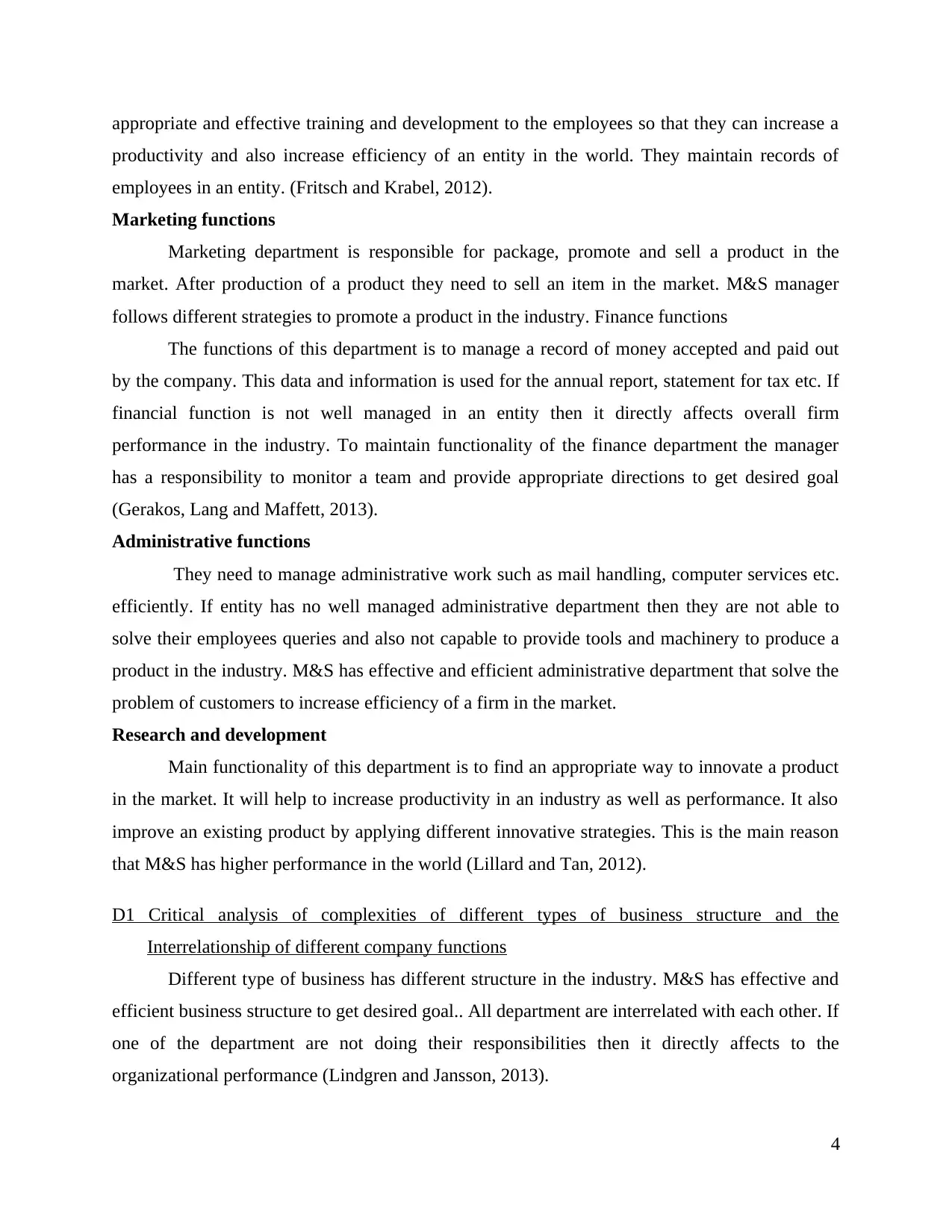
appropriate and effective training and development to the employees so that they can increase a
productivity and also increase efficiency of an entity in the world. They maintain records of
employees in an entity. (Fritsch and Krabel, 2012).
Marketing functions
Marketing department is responsible for package, promote and sell a product in the
market. After production of a product they need to sell an item in the market. M&S manager
follows different strategies to promote a product in the industry. Finance functions
The functions of this department is to manage a record of money accepted and paid out
by the company. This data and information is used for the annual report, statement for tax etc. If
financial function is not well managed in an entity then it directly affects overall firm
performance in the industry. To maintain functionality of the finance department the manager
has a responsibility to monitor a team and provide appropriate directions to get desired goal
(Gerakos, Lang and Maffett, 2013).
Administrative functions
They need to manage administrative work such as mail handling, computer services etc.
efficiently. If entity has no well managed administrative department then they are not able to
solve their employees queries and also not capable to provide tools and machinery to produce a
product in the industry. M&S has effective and efficient administrative department that solve the
problem of customers to increase efficiency of a firm in the market.
Research and development
Main functionality of this department is to find an appropriate way to innovate a product
in the market. It will help to increase productivity in an industry as well as performance. It also
improve an existing product by applying different innovative strategies. This is the main reason
that M&S has higher performance in the world (Lillard and Tan, 2012).
D1 Critical analysis of complexities of different types of business structure and the
Interrelationship of different company functions
Different type of business has different structure in the industry. M&S has effective and
efficient business structure to get desired goal.. All department are interrelated with each other. If
one of the department are not doing their responsibilities then it directly affects to the
organizational performance (Lindgren and Jansson, 2013).
4
productivity and also increase efficiency of an entity in the world. They maintain records of
employees in an entity. (Fritsch and Krabel, 2012).
Marketing functions
Marketing department is responsible for package, promote and sell a product in the
market. After production of a product they need to sell an item in the market. M&S manager
follows different strategies to promote a product in the industry. Finance functions
The functions of this department is to manage a record of money accepted and paid out
by the company. This data and information is used for the annual report, statement for tax etc. If
financial function is not well managed in an entity then it directly affects overall firm
performance in the industry. To maintain functionality of the finance department the manager
has a responsibility to monitor a team and provide appropriate directions to get desired goal
(Gerakos, Lang and Maffett, 2013).
Administrative functions
They need to manage administrative work such as mail handling, computer services etc.
efficiently. If entity has no well managed administrative department then they are not able to
solve their employees queries and also not capable to provide tools and machinery to produce a
product in the industry. M&S has effective and efficient administrative department that solve the
problem of customers to increase efficiency of a firm in the market.
Research and development
Main functionality of this department is to find an appropriate way to innovate a product
in the market. It will help to increase productivity in an industry as well as performance. It also
improve an existing product by applying different innovative strategies. This is the main reason
that M&S has higher performance in the world (Lillard and Tan, 2012).
D1 Critical analysis of complexities of different types of business structure and the
Interrelationship of different company functions
Different type of business has different structure in the industry. M&S has effective and
efficient business structure to get desired goal.. All department are interrelated with each other. If
one of the department are not doing their responsibilities then it directly affects to the
organizational performance (Lindgren and Jansson, 2013).
4
⊘ This is a preview!⊘
Do you want full access?
Subscribe today to unlock all pages.

Trusted by 1+ million students worldwide

TASK 2
P4 Positive and negative impact of macro environment in M&S
PESTLE analysis helps to identify the current condition of a firm. By knowing the macro
factors, they can improve a performance and also increase productivity in the industry. M&S is
the biggest retailer in the world they provide effective, efficient and good quality product to the
customer. Based on the consumer needs they provide innovative product to satisfy client need.
By providing product according to the client needs they will get higher performance in the
industry. Macro factors sometimes affects the overall performance of an entity because of the
new changes and modifications. PESTLE analysis of M&S as follows:
Political factor
Government provides different types of new rules and regulations to the company to
enhance and expand a business in the market. Government provide regulations such as health
and safety British standards such as planning for hazard identification, risk assessment and risk
control if organizations are not following these rules and policies then they will got loss in some
cases. M&S did not abide these standards as they charged for neglecting health and safety
regulations after a door fell on an employee (Liu and Ko, 2012).
Economic factor
Currently the economic condition is very uncertain and this is affect retail sales, as
peoples do not have spare cash to spend money on luxury products such as food, clothing. So
they are not able to purchase; luxury products in the market. To improve an economic condition
M&S has to provide items at cheaper rate so that they can attract a customer and also increase
productivity in the industry. M&S have been hit by this and have recently closed a number of
stores and have had to create job cuts by 2% of their 70,000 employees.
Social factor
In last few years' society has been changed. Asda is the biggest competitor of M&S in the
industry. Asda provide food products online as a part of a plan to become a multichannel retailer
so this is the big factor for challenging. To maintain brand recognition and increment in
productivity they also need to apply different type of innovative technologies in the firm (Michel
and Rieunier, 2012).
Technological factor
5
P4 Positive and negative impact of macro environment in M&S
PESTLE analysis helps to identify the current condition of a firm. By knowing the macro
factors, they can improve a performance and also increase productivity in the industry. M&S is
the biggest retailer in the world they provide effective, efficient and good quality product to the
customer. Based on the consumer needs they provide innovative product to satisfy client need.
By providing product according to the client needs they will get higher performance in the
industry. Macro factors sometimes affects the overall performance of an entity because of the
new changes and modifications. PESTLE analysis of M&S as follows:
Political factor
Government provides different types of new rules and regulations to the company to
enhance and expand a business in the market. Government provide regulations such as health
and safety British standards such as planning for hazard identification, risk assessment and risk
control if organizations are not following these rules and policies then they will got loss in some
cases. M&S did not abide these standards as they charged for neglecting health and safety
regulations after a door fell on an employee (Liu and Ko, 2012).
Economic factor
Currently the economic condition is very uncertain and this is affect retail sales, as
peoples do not have spare cash to spend money on luxury products such as food, clothing. So
they are not able to purchase; luxury products in the market. To improve an economic condition
M&S has to provide items at cheaper rate so that they can attract a customer and also increase
productivity in the industry. M&S have been hit by this and have recently closed a number of
stores and have had to create job cuts by 2% of their 70,000 employees.
Social factor
In last few years' society has been changed. Asda is the biggest competitor of M&S in the
industry. Asda provide food products online as a part of a plan to become a multichannel retailer
so this is the big factor for challenging. To maintain brand recognition and increment in
productivity they also need to apply different type of innovative technologies in the firm (Michel
and Rieunier, 2012).
Technological factor
5
Paraphrase This Document
Need a fresh take? Get an instant paraphrase of this document with our AI Paraphraser
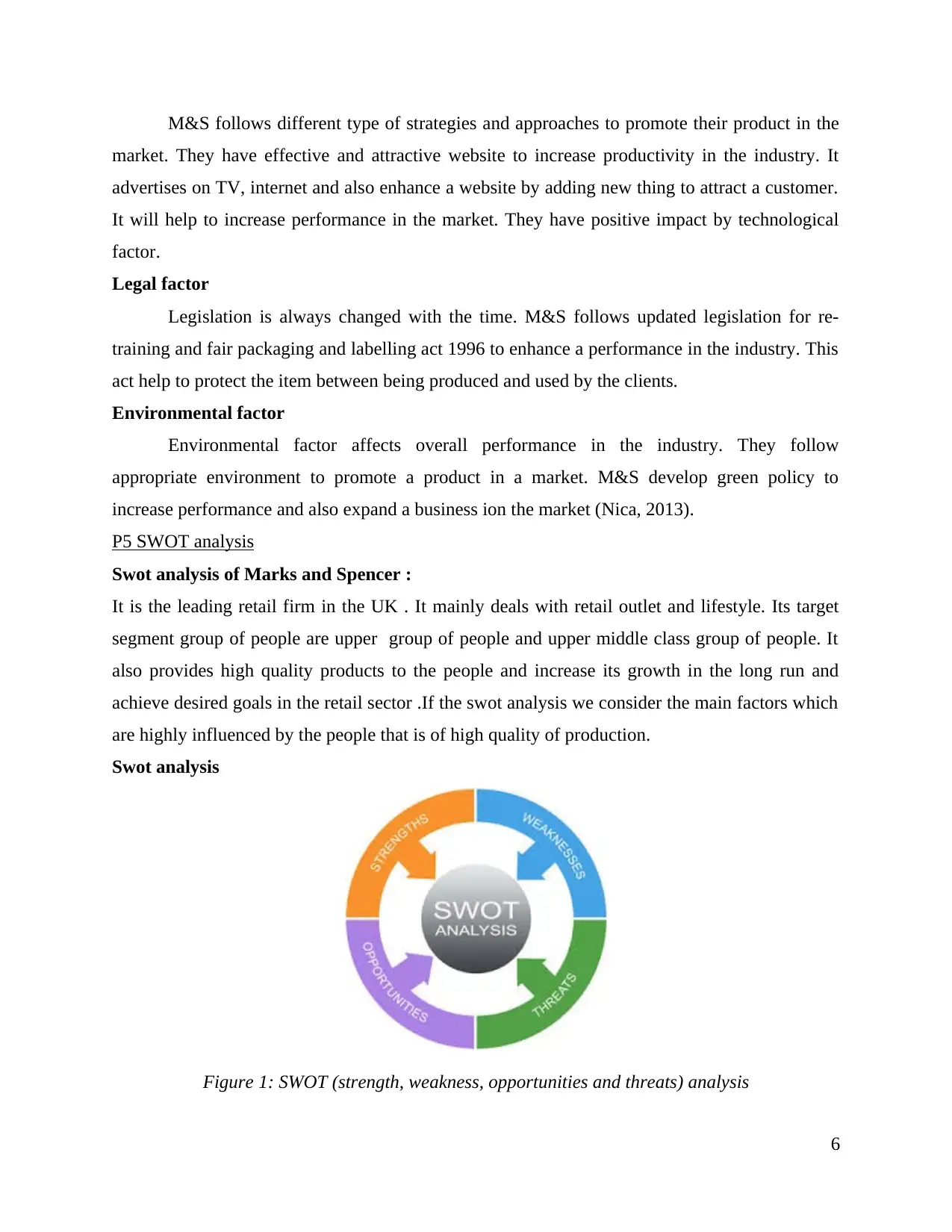
M&S follows different type of strategies and approaches to promote their product in the
market. They have effective and attractive website to increase productivity in the industry. It
advertises on TV, internet and also enhance a website by adding new thing to attract a customer.
It will help to increase performance in the market. They have positive impact by technological
factor.
Legal factor
Legislation is always changed with the time. M&S follows updated legislation for re-
training and fair packaging and labelling act 1996 to enhance a performance in the industry. This
act help to protect the item between being produced and used by the clients.
Environmental factor
Environmental factor affects overall performance in the industry. They follow
appropriate environment to promote a product in a market. M&S develop green policy to
increase performance and also expand a business ion the market (Nica, 2013).
P5 SWOT analysis
Swot analysis of Marks and Spencer :
It is the leading retail firm in the UK . It mainly deals with retail outlet and lifestyle. Its target
segment group of people are upper group of people and upper middle class group of people. It
also provides high quality products to the people and increase its growth in the long run and
achieve desired goals in the retail sector .If the swot analysis we consider the main factors which
are highly influenced by the people that is of high quality of production.
Swot analysis
Figure 1: SWOT (strength, weakness, opportunities and threats) analysis
6
market. They have effective and attractive website to increase productivity in the industry. It
advertises on TV, internet and also enhance a website by adding new thing to attract a customer.
It will help to increase performance in the market. They have positive impact by technological
factor.
Legal factor
Legislation is always changed with the time. M&S follows updated legislation for re-
training and fair packaging and labelling act 1996 to enhance a performance in the industry. This
act help to protect the item between being produced and used by the clients.
Environmental factor
Environmental factor affects overall performance in the industry. They follow
appropriate environment to promote a product in a market. M&S develop green policy to
increase performance and also expand a business ion the market (Nica, 2013).
P5 SWOT analysis
Swot analysis of Marks and Spencer :
It is the leading retail firm in the UK . It mainly deals with retail outlet and lifestyle. Its target
segment group of people are upper group of people and upper middle class group of people. It
also provides high quality products to the people and increase its growth in the long run and
achieve desired goals in the retail sector .If the swot analysis we consider the main factors which
are highly influenced by the people that is of high quality of production.
Swot analysis
Figure 1: SWOT (strength, weakness, opportunities and threats) analysis
6
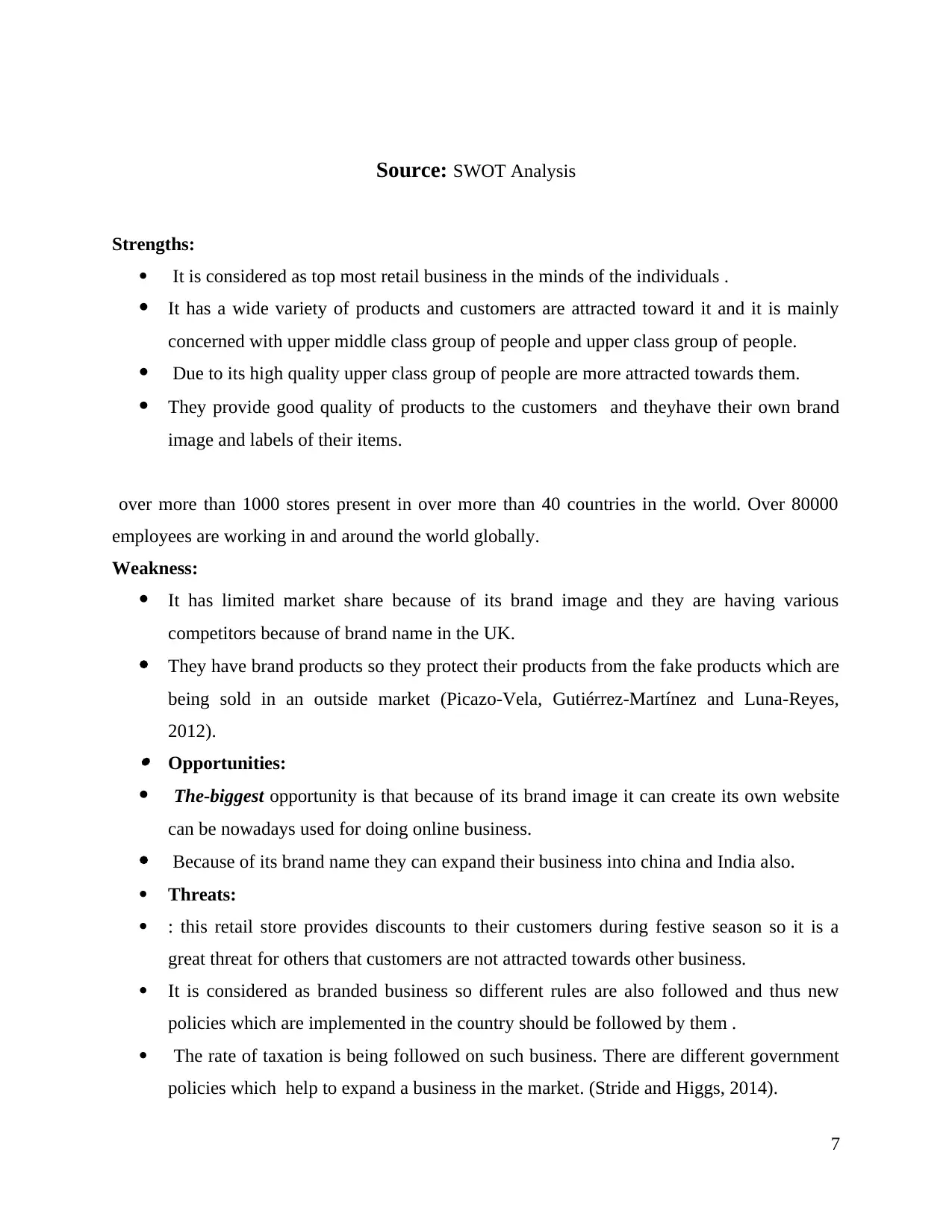
Source: SWOT Analysis
Strengths:
It is considered as top most retail business in the minds of the individuals .
It has a wide variety of products and customers are attracted toward it and it is mainly
concerned with upper middle class group of people and upper class group of people.
Due to its high quality upper class group of people are more attracted towards them.
They provide good quality of products to the customers and theyhave their own brand
image and labels of their items.
over more than 1000 stores present in over more than 40 countries in the world. Over 80000
employees are working in and around the world globally.
Weakness:
It has limited market share because of its brand image and they are having various
competitors because of brand name in the UK.
They have brand products so they protect their products from the fake products which are
being sold in an outside market (Picazo-Vela, Gutiérrez-Martínez and Luna-Reyes,
2012). Opportunities:
The-biggest opportunity is that because of its brand image it can create its own website
can be nowadays used for doing online business.
Because of its brand name they can expand their business into china and India also.
Threats:
: this retail store provides discounts to their customers during festive season so it is a
great threat for others that customers are not attracted towards other business.
It is considered as branded business so different rules are also followed and thus new
policies which are implemented in the country should be followed by them .
The rate of taxation is being followed on such business. There are different government
policies which help to expand a business in the market. (Stride and Higgs, 2014).
7
Strengths:
It is considered as top most retail business in the minds of the individuals .
It has a wide variety of products and customers are attracted toward it and it is mainly
concerned with upper middle class group of people and upper class group of people.
Due to its high quality upper class group of people are more attracted towards them.
They provide good quality of products to the customers and theyhave their own brand
image and labels of their items.
over more than 1000 stores present in over more than 40 countries in the world. Over 80000
employees are working in and around the world globally.
Weakness:
It has limited market share because of its brand image and they are having various
competitors because of brand name in the UK.
They have brand products so they protect their products from the fake products which are
being sold in an outside market (Picazo-Vela, Gutiérrez-Martínez and Luna-Reyes,
2012). Opportunities:
The-biggest opportunity is that because of its brand image it can create its own website
can be nowadays used for doing online business.
Because of its brand name they can expand their business into china and India also.
Threats:
: this retail store provides discounts to their customers during festive season so it is a
great threat for others that customers are not attracted towards other business.
It is considered as branded business so different rules are also followed and thus new
policies which are implemented in the country should be followed by them .
The rate of taxation is being followed on such business. There are different government
policies which help to expand a business in the market. (Stride and Higgs, 2014).
7
⊘ This is a preview!⊘
Do you want full access?
Subscribe today to unlock all pages.

Trusted by 1+ million students worldwide
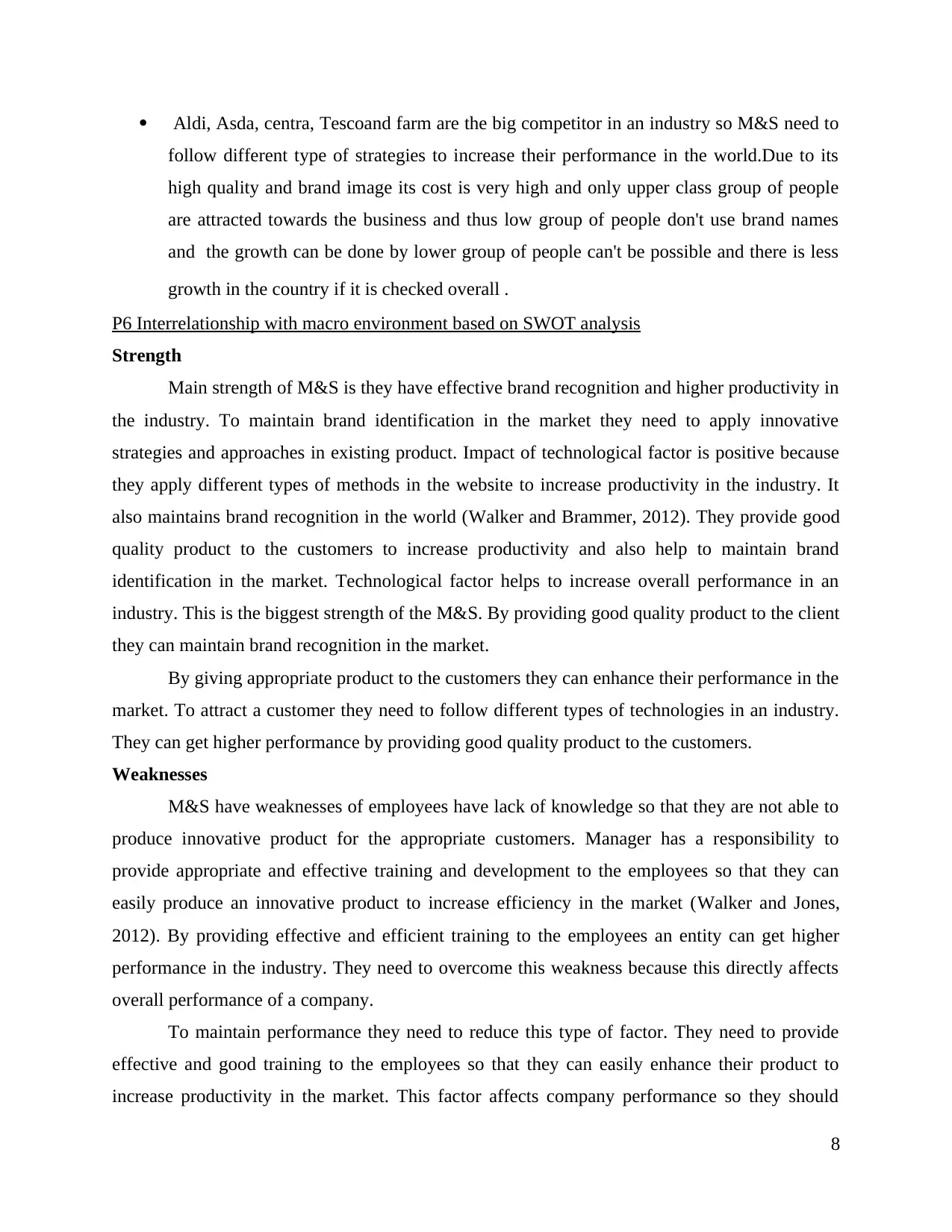
Aldi, Asda, centra, Tescoand farm are the big competitor in an industry so M&S need to
follow different type of strategies to increase their performance in the world.Due to its
high quality and brand image its cost is very high and only upper class group of people
are attracted towards the business and thus low group of people don't use brand names
and the growth can be done by lower group of people can't be possible and there is less
growth in the country if it is checked overall .
P6 Interrelationship with macro environment based on SWOT analysis
Strength
Main strength of M&S is they have effective brand recognition and higher productivity in
the industry. To maintain brand identification in the market they need to apply innovative
strategies and approaches in existing product. Impact of technological factor is positive because
they apply different types of methods in the website to increase productivity in the industry. It
also maintains brand recognition in the world (Walker and Brammer, 2012). They provide good
quality product to the customers to increase productivity and also help to maintain brand
identification in the market. Technological factor helps to increase overall performance in an
industry. This is the biggest strength of the M&S. By providing good quality product to the client
they can maintain brand recognition in the market.
By giving appropriate product to the customers they can enhance their performance in the
market. To attract a customer they need to follow different types of technologies in an industry.
They can get higher performance by providing good quality product to the customers.
Weaknesses
M&S have weaknesses of employees have lack of knowledge so that they are not able to
produce innovative product for the appropriate customers. Manager has a responsibility to
provide appropriate and effective training and development to the employees so that they can
easily produce an innovative product to increase efficiency in the market (Walker and Jones,
2012). By providing effective and efficient training to the employees an entity can get higher
performance in the industry. They need to overcome this weakness because this directly affects
overall performance of a company.
To maintain performance they need to reduce this type of factor. They need to provide
effective and good training to the employees so that they can easily enhance their product to
increase productivity in the market. This factor affects company performance so they should
8
follow different type of strategies to increase their performance in the world.Due to its
high quality and brand image its cost is very high and only upper class group of people
are attracted towards the business and thus low group of people don't use brand names
and the growth can be done by lower group of people can't be possible and there is less
growth in the country if it is checked overall .
P6 Interrelationship with macro environment based on SWOT analysis
Strength
Main strength of M&S is they have effective brand recognition and higher productivity in
the industry. To maintain brand identification in the market they need to apply innovative
strategies and approaches in existing product. Impact of technological factor is positive because
they apply different types of methods in the website to increase productivity in the industry. It
also maintains brand recognition in the world (Walker and Brammer, 2012). They provide good
quality product to the customers to increase productivity and also help to maintain brand
identification in the market. Technological factor helps to increase overall performance in an
industry. This is the biggest strength of the M&S. By providing good quality product to the client
they can maintain brand recognition in the market.
By giving appropriate product to the customers they can enhance their performance in the
market. To attract a customer they need to follow different types of technologies in an industry.
They can get higher performance by providing good quality product to the customers.
Weaknesses
M&S have weaknesses of employees have lack of knowledge so that they are not able to
produce innovative product for the appropriate customers. Manager has a responsibility to
provide appropriate and effective training and development to the employees so that they can
easily produce an innovative product to increase efficiency in the market (Walker and Jones,
2012). By providing effective and efficient training to the employees an entity can get higher
performance in the industry. They need to overcome this weakness because this directly affects
overall performance of a company.
To maintain performance they need to reduce this type of factor. They need to provide
effective and good training to the employees so that they can easily enhance their product to
increase productivity in the market. This factor affects company performance so they should
8
Paraphrase This Document
Need a fresh take? Get an instant paraphrase of this document with our AI Paraphraser

apply different strategies and approaches. It will help to get higher performance and also help to
get desired goal of an entity in the industry.
CONCLUSION
Effective Business environment help to get higher performance in the industry. It will
also help to increase productivity and expand a business in the market. M&S provide good and
best quality product and services to its customers. Based on the consumer needs they provide
items and services in the market.. there are different departments in a firm such as HR, finance
and administration etc All these departments help to maintain business environment in an
industry. By managing functions of different departments then they can easily get desired goal of
a company in the industry. Private, public and charity companies have different rules and
regulation to get desired goal in the market. By providing effective, efficient services to the
client so that they can get higher performance and also expand a business in an industry.
9
get desired goal of an entity in the industry.
CONCLUSION
Effective Business environment help to get higher performance in the industry. It will
also help to increase productivity and expand a business in the market. M&S provide good and
best quality product and services to its customers. Based on the consumer needs they provide
items and services in the market.. there are different departments in a firm such as HR, finance
and administration etc All these departments help to maintain business environment in an
industry. By managing functions of different departments then they can easily get desired goal of
a company in the industry. Private, public and charity companies have different rules and
regulation to get desired goal in the market. By providing effective, efficient services to the
client so that they can get higher performance and also expand a business in an industry.
9
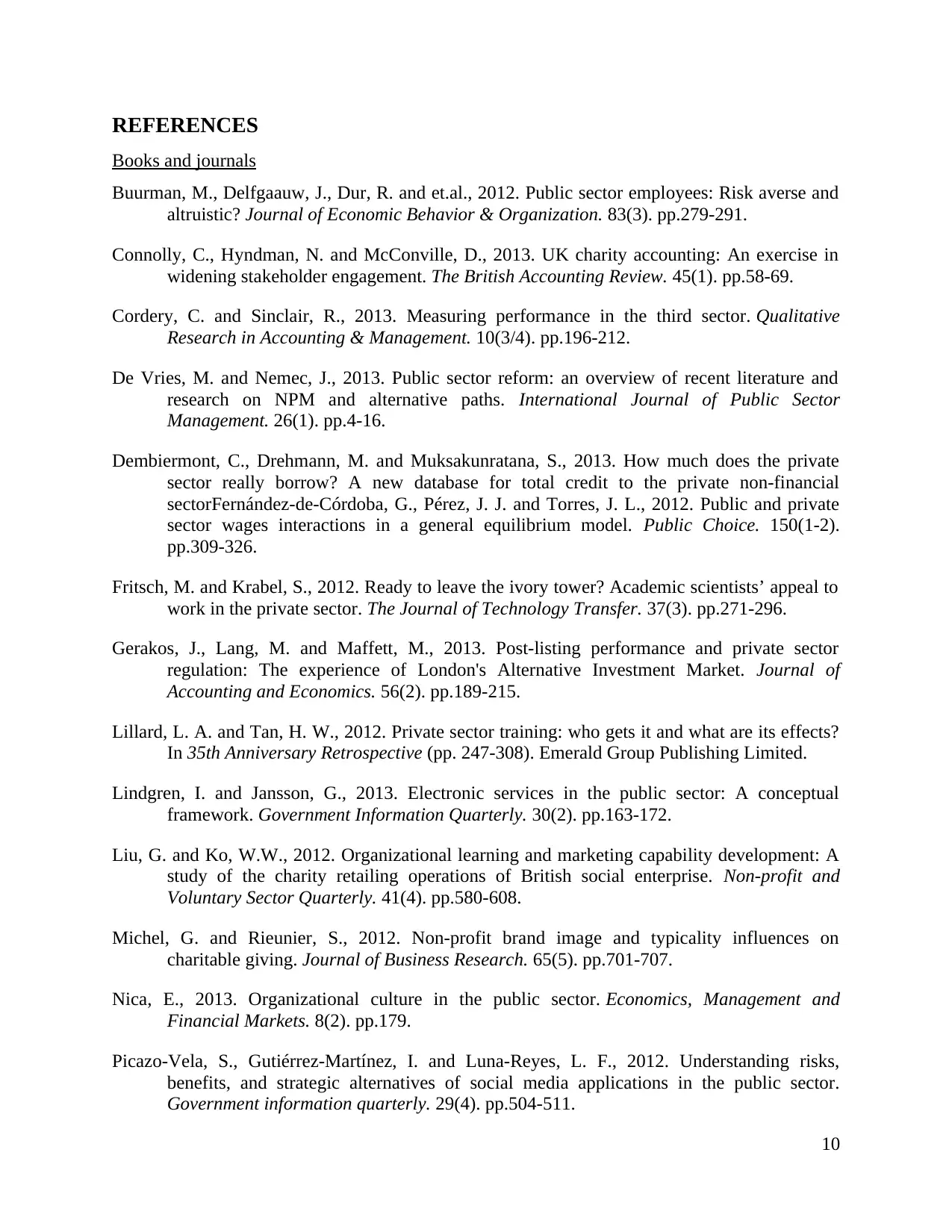
REFERENCES
Books and journals
Buurman, M., Delfgaauw, J., Dur, R. and et.al., 2012. Public sector employees: Risk averse and
altruistic? Journal of Economic Behavior & Organization. 83(3). pp.279-291.
Connolly, C., Hyndman, N. and McConville, D., 2013. UK charity accounting: An exercise in
widening stakeholder engagement. The British Accounting Review. 45(1). pp.58-69.
Cordery, C. and Sinclair, R., 2013. Measuring performance in the third sector. Qualitative
Research in Accounting & Management. 10(3/4). pp.196-212.
De Vries, M. and Nemec, J., 2013. Public sector reform: an overview of recent literature and
research on NPM and alternative paths. International Journal of Public Sector
Management. 26(1). pp.4-16.
Dembiermont, C., Drehmann, M. and Muksakunratana, S., 2013. How much does the private
sector really borrow? A new database for total credit to the private non-financial
sectorFernández-de-Córdoba, G., Pérez, J. J. and Torres, J. L., 2012. Public and private
sector wages interactions in a general equilibrium model. Public Choice. 150(1-2).
pp.309-326.
Fritsch, M. and Krabel, S., 2012. Ready to leave the ivory tower? Academic scientists’ appeal to
work in the private sector. The Journal of Technology Transfer. 37(3). pp.271-296.
Gerakos, J., Lang, M. and Maffett, M., 2013. Post-listing performance and private sector
regulation: The experience of London's Alternative Investment Market. Journal of
Accounting and Economics. 56(2). pp.189-215.
Lillard, L. A. and Tan, H. W., 2012. Private sector training: who gets it and what are its effects?
In 35th Anniversary Retrospective (pp. 247-308). Emerald Group Publishing Limited.
Lindgren, I. and Jansson, G., 2013. Electronic services in the public sector: A conceptual
framework. Government Information Quarterly. 30(2). pp.163-172.
Liu, G. and Ko, W.W., 2012. Organizational learning and marketing capability development: A
study of the charity retailing operations of British social enterprise. Non-profit and
Voluntary Sector Quarterly. 41(4). pp.580-608.
Michel, G. and Rieunier, S., 2012. Non-profit brand image and typicality influences on
charitable giving. Journal of Business Research. 65(5). pp.701-707.
Nica, E., 2013. Organizational culture in the public sector. Economics, Management and
Financial Markets. 8(2). pp.179.
Picazo-Vela, S., Gutiérrez-Martínez, I. and Luna-Reyes, L. F., 2012. Understanding risks,
benefits, and strategic alternatives of social media applications in the public sector.
Government information quarterly. 29(4). pp.504-511.
10
Books and journals
Buurman, M., Delfgaauw, J., Dur, R. and et.al., 2012. Public sector employees: Risk averse and
altruistic? Journal of Economic Behavior & Organization. 83(3). pp.279-291.
Connolly, C., Hyndman, N. and McConville, D., 2013. UK charity accounting: An exercise in
widening stakeholder engagement. The British Accounting Review. 45(1). pp.58-69.
Cordery, C. and Sinclair, R., 2013. Measuring performance in the third sector. Qualitative
Research in Accounting & Management. 10(3/4). pp.196-212.
De Vries, M. and Nemec, J., 2013. Public sector reform: an overview of recent literature and
research on NPM and alternative paths. International Journal of Public Sector
Management. 26(1). pp.4-16.
Dembiermont, C., Drehmann, M. and Muksakunratana, S., 2013. How much does the private
sector really borrow? A new database for total credit to the private non-financial
sectorFernández-de-Córdoba, G., Pérez, J. J. and Torres, J. L., 2012. Public and private
sector wages interactions in a general equilibrium model. Public Choice. 150(1-2).
pp.309-326.
Fritsch, M. and Krabel, S., 2012. Ready to leave the ivory tower? Academic scientists’ appeal to
work in the private sector. The Journal of Technology Transfer. 37(3). pp.271-296.
Gerakos, J., Lang, M. and Maffett, M., 2013. Post-listing performance and private sector
regulation: The experience of London's Alternative Investment Market. Journal of
Accounting and Economics. 56(2). pp.189-215.
Lillard, L. A. and Tan, H. W., 2012. Private sector training: who gets it and what are its effects?
In 35th Anniversary Retrospective (pp. 247-308). Emerald Group Publishing Limited.
Lindgren, I. and Jansson, G., 2013. Electronic services in the public sector: A conceptual
framework. Government Information Quarterly. 30(2). pp.163-172.
Liu, G. and Ko, W.W., 2012. Organizational learning and marketing capability development: A
study of the charity retailing operations of British social enterprise. Non-profit and
Voluntary Sector Quarterly. 41(4). pp.580-608.
Michel, G. and Rieunier, S., 2012. Non-profit brand image and typicality influences on
charitable giving. Journal of Business Research. 65(5). pp.701-707.
Nica, E., 2013. Organizational culture in the public sector. Economics, Management and
Financial Markets. 8(2). pp.179.
Picazo-Vela, S., Gutiérrez-Martínez, I. and Luna-Reyes, L. F., 2012. Understanding risks,
benefits, and strategic alternatives of social media applications in the public sector.
Government information quarterly. 29(4). pp.504-511.
10
⊘ This is a preview!⊘
Do you want full access?
Subscribe today to unlock all pages.

Trusted by 1+ million students worldwide
1 out of 14
Related Documents
Your All-in-One AI-Powered Toolkit for Academic Success.
+13062052269
info@desklib.com
Available 24*7 on WhatsApp / Email
![[object Object]](/_next/static/media/star-bottom.7253800d.svg)
Unlock your academic potential
Copyright © 2020–2025 A2Z Services. All Rights Reserved. Developed and managed by ZUCOL.





